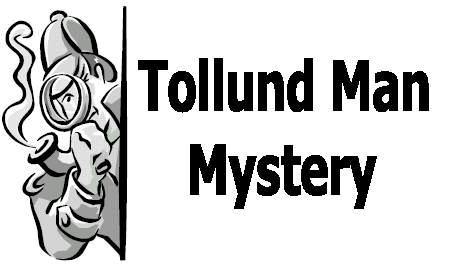
What is a History Detective?
A History Detective is somebody who looks at evidence from the past.
They do not want to catch criminals or bring anybody to justice with
this evidence. History Detectives want to learn about the past from
the clues other people leave behind. The further back in the past we
look the harder it is to find clues.Today you are going to be a History Detective. You are going to
investigate a murder that happened in Denmark during the Iron Age.
Using PRIMARY and SECONDARY evidence about the murder you will
attempt to work out why a man died. The primary sources will be both written and archaeological artefacts.If you think that YOU are up to this challenge then read the following
information carefully because the Tollund Man is relying on you to decide
who killed him, and how and why they did it.
![]()

Source A shows the body found in a peat bog on Tollund Fen in Denmark in May 1950. Two men were digging peat for burning. As they worked they suddenly saw in the peat layer a face so fresh they thought they had come across a recent murder.
They called the police. The men carefully removed the peat from the body till more of him could be seen. The man lay on his right side as if he was asleep. He wore no clothes, except for a pointed skin cap and a smooth hide belt. His hair was cut short. Round the neck was a rope noose and an iron neck ring. It was drawn tight around his neck and throat.

These items (Source B)
were not found on the Tollund man but are similar to those around his
neck. The items are a rope noose and a neck ring. Iron Age people buried
neck rings with their dead as an offering to the Spring Goddess.
This noose was around the neck of an Iron Age man who was found buried in
Borre Fen in Denmark. His last meal had been a vegetable soup made from
Spring seeds. Across his body was a birch branch 1m long and 4.5cm thick.
Next to the noose in the picture is a neck ring. The Iron Age people used
to bury these in the bogs as offerings to the Spring Goddess.
SOURCE C
SCIENTIFIC REPORT
Age :
The heart and organs were
healthy. The wisdom teeth had
grown. These appear in
people around 20 years of age.
Stomach: The man had eaten soup at least 12 hrs before he died. The soup was made up of seeds that were connected only with the Spring
DOD
: When they dug the grave some plants were trapped under the body. They were about 2000 years old.Map showing the north German tribes, that were living where present Denmark is. Also Tollund, Grauballe and Borre Fens.

This man was found buried in a bog at Grauballe in Denmark. His throat had been cut from ear to ear. Scientists discovered that he had been buried 1650 years ago. His last meal, eaten shortly before his death, had been a vegetable soup made from Spring seeds.
 SOURCE E
SOURCE EAn Earth Goddess of Spring statue found in a bog.
SOURCE F
"There is nothing unusual about these tribes except their worship of Mother Earth, the Goddess of Spring. They believe that each spring she rides through the tribes. A chariot carries a statue of the Goddess in a procession. After this the chariot and her robes.....are washed clean in a hidden lake. This task is done by slaves who are then..." killed.
(Written in 97-98 AD by Cornelius Tacitus, a Roman, in his book about the German tribes).
Some of the above material is from a unit by Ms Boughey http://www.schoolhistory.co.uk/year7links/history/tollund_man_updated.pdf
Your Assignment:
Now it is time for you to be the History Detective! The
report you write must be in the form of an
Exposition or Formal Essay.
It should be
structured
with an
introduction, paragraphs that start with a topic sentence, and a conclusion at
the end.
You should use Link Words at the start of each paragraph such as:
'Firstly...',
'Secondly...' ,
'Another reason why...'
'Furthermore...'
There is also evidence to suggest that....'
- For more tips on writing your essay, use the How to Structure an Essay sheet you were given.
Question : Using all of the available evidence, explain why and how Tolland Man was killed.
- The essay length is to be two pages hand written or one and a quarter pages typed.
After
you have discussed the above sources in class, you
will be given one week to write your exposition at home. Date
due:________
OR
You will be asked to write the exposition (essay) under exam conditions in
class. You will be able to bring in this booklet of resources to help you,
but no other notes.
- For further research:
- 1. For an interactive study of the body
- 2. Archaeological Institute of America
- 1. For an interactive study of the body
- - "Bodies of the bogs"
http://www.archaeology.org/online/features
/bog/index.html#index

